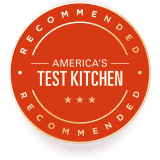The Best Chef's Knives for Kids
Equipment Review
Feeding your baby can be stressful; the spoon you use shouldn’t make it more so.
Published Mar. 5, 2021.

Once you start feeding solids to your kiddo, at around 4 months, a baby spoon sized for smaller mouths is useful. To find the best spoon for adults to use for feeding babies (versus ones the kids hold themselves), we tested 10 spoons, made from silicone, plastic, bamboo, and metal, using them to feed seven little testers, ages 4 months to 2 years, for a month. We considered how comfortable they were to hold, how well they scooped and served, and how easy they were to clean.
We found that fatter, rounded, longer handles were the most comfortable for adults to hold. Five minutes of holding one spoon with a short, narrow, sharp metal handle had us wanting to chuck it across the room. Feeding a wiggling, uncooperative child is chaotic, so a grippy handle was key, too. Silicone was optimal here.
Some of the spoons were overdesigned, with dramatically curved handles or angled bowls. Simpler was better. Spoons that were relatively straight from bowl to handle were more comfortable to hold and angle into the babies’ mouths. The amount of flex was important, too. The handle of one spoon was so bendy that using it was like trying to scoop and serve with a Twizzler. Spoons with relatively stiff handles were easier to direct.
Bowls with soft edges were better at corralling lingering bits of food (from faces, bowls, plates, etc.) because they gently molded to surfaces and faces, scraping more cleanly.
Bowl size played into our rankings as well. Some bowls were too broad, too narrow, too deep, or too flat. The best bowls were right in the middle, big enough to serve a good-size scoop and hold runnier foods but small enough to fit into little mouths.
Several of the spoons featured bowls that turned white when the food was too hot to serve. Some of us found this handy.
Several spoons had bumps on the bottoms of their handles that are designed to raise the bowls up off of counters and avoid contamination. We were mostly ambivalent about this feature. There really shouldn’t be anything that dangerous on the counter, for safety reasons. Perhaps if you were camping or feeding your baby on the go, these built-in spoon rests might come in handy.
Foods such as carrots and turmeric can discolor plastic and silicone. We saw a problem with only one particular silicone spoon; the rest were fine. Another, the only spoon that was not dishwasher-safe, had a silicone head and a bamboo handle that came apart for cleaning. We worried about the inside of this spoon’s silicone head getting moldy after...

The mission of America’s Test Kitchen Reviews is to find the best equipment and ingredients for the home cook through rigorous, hands-on testing. We stand behind our winners so much that we even put our seal of approval on them.

Hannah is an executive editor for ATK Reviews and cohost of Gear Heads on YouTube.

This is a members' feature.